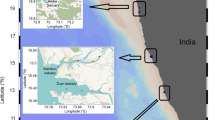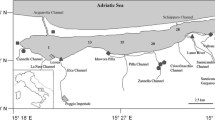Abstract
In order to study the importance of phytoplankton as a food source for benthic consumers, Kinsale harbour, a small estuary in the southwest of Ireland, was sampled on a monthly basis during the course of 1994. Nutrients, salinity, temperature, pigments (chlorophyll a and phaeopigments) and phytoplankton species composition were determined along longitudinal and vertical profiles. Based on salinity distributions, Kinsale harbour can be classified as a partially mixed estuary. River discharge and tidal mixing result in a strong estuarine circulation and an intensive exchange between the estuary and coastal waters. As a result, residence time is too low (< 1 day) for autochthonous phytoplankton populations to develop and phytoplankton observed in Kinsale harbour is predominantly advected from coastal waters. High concentrations of phaeopigments, exceeding those of chlorophyll a, were observed at the uppermost stations sampled, suggesting mass mortality and accumulation of coastal phytoplankton within the estuary. Possible causes for this phenomenon include osmotic stress or grazing by macrozooplankton within the estuary and the subsequent entrapment of senescent phytoplankton or faecal pellets in the baroclinic circulation near the salt wedge. It is suggested that in small estuaries, like Kinsale harbour, which are strongly influenced by river discharge, estuarine circulation induces the import of coastal phytoplankton into the estuary and provides an allochthonous carbon source to consumers within the estuary.
Similar content being viewed by others
References
Ball, B., R. Raine & D. Douglas, 1997. Phytoplankton and particulate matter in Carlingford Lough, Ireland: an assessment of food availability and the impact of bivalve culture. Estuaries 20: 430-440.
Bérard-Therriault, L., A. Cardinal & M. Poulin, 1987. Les diatomées (Bacillariophyceae) benthiques de substrats durs des eaux marines et saumâtres du Quebec. 8. Centrales. Nat. can. 114: 81-103.
Boaden, P. J. S. & R. Seed, 1985. An introduction to coastal ecology. Chapman & Hall, Glasgow, 218 pp.
Cadée, G. C., 1978. Primary production and chlorophyll in the Zaire river, estuary and plume. Neth. J. Sea Res. 12: 368-381.
Cadée, G. C., 1983. Behaviouor of POC, DOC and fluorescence in the freshwater tidal compartment of the river Ems. Mitt. Geol.-Paläeont. Inst. Univ. Hamburg 55: 331-342.
Cadée, G. C. & J. Hegeman, 1974. Primary production of phytoplankton in the Dutch Wadden Sea. Neth. J. Sea Res. 8: 240-259.
Day, J. W., C. A. S. Hall, W. M. Kemp & A. Yá nez-Arancibia, 1989. Estuarine ecology. John Wiley, London, 400 pp.
de Madariaga, I., L. González-Azpiri, F. Villate & E. Orive, 1992. Plankton responses to hydrological changes induced by freshets in a shallow mesotidal estuary. Estuar. coast. shelf Sci. 35: 425-434.
Denys, L., 1991. A checklist of the diatoms of the Holocene deposits of the western Belgian coastal plain with a survey of their apparent ecological requirements. I. Introduction, ecological code and complete list. Belgische geologische dienst, Professional Paper Nr. 246, 1-41.
Deegan, L. A. & R. H. Garrit, 1997. Evidence for spatial variability in estuarine food webs. Mar. Ecol. Progr. Ser. 147: 31-47.
Drebes, G., 1974. Marines phytoplankton, Eine Auswahl der Helgoländer Planktonalgen (Diatomeen, Peridineen). Georg Thieme Verlag, Stuttgart, 186 pp.
Dyer, K.R., 1973. Estuaries: a Physical Introduction. John Wiley, London, 140 pp.
Dyer, K. R., 1979. Estuarine Hydrography and Sedimentation. EBSA Handbook. Cambridge University Press, Cambridge: 1-18.
Findlay, S., M. L. Pace, D. Lints, J. J. Cole, N. F. Caraco & B. Peierls, 1991. Weak coupling of bacterial and algal production in a heterotrophic ecosystem: the Hudson River estuary. Limnol. Oceanogr. 36: 268-278.
Findlay, S., M. L. Pace, D. Lints & K. Howe, 1992. Bacterial metabolism of organic carbon in the tidal freshwater Hudson Estuary. Mar. Ecol. Progr. Ser. 89: 147-153.
Graf, G. & R. Rosenberg, 1997. Bioresuspension and biodeposition: a review. J. Mar. Systems 11: 269-278.
Hasle, G. R., 1978. The inverted microscope method. In Sournia, A. (ed.), Monographs on Oceanographic Methodology. 6. Phytoplankton manual. Unesco, Norwich: 88-96.
Herman, P. M. J., J. J. Middelburg, J. Van De Koppel & C. H. R. Heip. Ecology of estuarine macrobenthos. Adv. ecol. Res. (in press).
Jeffrey, S.W., R. F. C. Mantoura & S.W. Wright, 1997. Phytoplankton pigments in oceanography: guidelines to modern methods. UNESCO Publishing, Paris: 661 pp.
Jongman, R. H. G., C. J. F. Ter Braak & O. F. Van Tongeren, 1987. Data analysis in community and landscape ecology. Pudoc, Wageningen: 299 pp.
Largier, J. L., 1993. Estuarine fronts: how important are they? Estuaries 16: 1-11.
Laprise, R. & J. J. Dodson, 1993. Nature of the environmental variability experienced by benthic and pelagic animals in the St. Lawrence Estuary, Canada. Mar. Ecol. Progr. Ser. 94: 129-139.
Levasseur, M. E., J. C. Theriault & L. Legendre, 1984. Hierarchical control of phytoplankton by physical factors. Mar. Ecol. Progr. Ser. 19: 211-221.
Lund, J. W. H., C. Kipling & E. D. Le Cren, 1958. The inverted microscope method of estimating algal numbers and the statistical basis of estimating numbers by counting. Hydrobiologia 11: 143-170.
Mackas, D. L. & P. J. Harrison, 1997. Nitrogenous nutrient sources and sinks in the Juan de Fuca strait/strait of Georgia/Puget Sound estuarine system: assessing the potential for eutrophication. Estuar. coast. shelf. Sci. 44: 1-21.
Mallin, M. A., H. W. Paerl, J. Rudek & P. W. Bates, 1993. Regulation of estuarine primary production by watershed rainfall and river flow. Mar. Ecol. Progr. Ser. 93: 199-203.
Malone, T. C., P. J. Neale & D. Boardman, 1980. Influences of estuarine circulation on the distribution and biomass of phytoplankton size fractions. In Kennedy, V. (ed.), Estuarine Perspectives. Academic Press, New York: 249-262.
McMahon, T., R. C. T. Raine, T. Fast, L. Kies & J. W. Patching, 1992. Phytoplankton biomass, light attenuation and mixing in the Shannon estuary, Ireland. J. mar. biol. Ass. U.K. 72: 709-720.
Miller, R. L. & D. L. Kamykowski, 1986. Effects of temperature and, salinity, irradiance and diurnal periodicity on growth and photosynthesis in the diatom Nitzschia americana: lightsaturated growth. J. Phycol. 22: 339-348.
Passow, U., 1991. Species-specific sedimentation and sinking velocities of diatoms. Mar. Biol. 108: 449-455.
Postma, H. Von & K. Kalle, 1955. Die Entstehung von Trübungszonen im Unterlauf der Flüsse, speziell im Hinblick auf die Verhältnisse in der Unterelbe. Deutschen Hydrografischen Zeitschrift 8: 137-144.
Postma, H., 1967. Sediment transport and sedimentation in the estuarine environment. In Lauff, G. H. (ed.), Estuaries. American Association for Advancement of Science, publication 83: 158-179.
Raine, R., J. O'Mahony, T. McMahon & C. Roden, 1990a. Hydrography and phytoplankton of waters off south-west Ireland. Estuar. coast. shelf Sci. 30: 579-592.
Raine, R., T. McMahon, J. O'Mahony, M. Moloney & C. Roden, 1990b. Water circulation and phytoplankton populations in two estuaries on the west coast of Ireland. In Chambers, P. L. & C.M. Chambers (eds), Estuarine Ecotoxicology. JAPAGA, Wicklow: 19-28.
Raine, R., B. Joyce, J. Richard, Y. Pazos, M. Moloney, K. J. Jones & J. W. Patching, 1993a. The development of a bloom of the dinoflagellate Gyrodinium aureolum (Hulbert) on the south-west Irish coast. ICES J. mar. Sci. 50: 461-496.
Raine, R., T. McMahon & C. Roden, 1993b. A review of the summer phytoplankton distribution in Irish coastal waters: a biogeography related to physical oceanography. In Costello, M. J. & K. S. Kelly (eds), Biogeography of Ireland: Past, Present, and Future. Occ. Publ. Ireland biogeogr. Soc. 2: 99-111.
Redfield, A. C., B. H. Ketchum & F. A. Richards, 1963. The influence of organisms on the composition of sea-water. In Hill, N. M. (ed.), The Sea. Wiley-Interscience, New York: 26-77.
Reynolds, C. S., 1984. The Ecology of Freshwater Phytoplankton. Cambridge University Press, Cambridge: 384 pp.
Ricard, M., 1987. Atlas du phytoplankton marin: volume 2, Diatomophycées. Centre National de la Reserche Scientifique, Paris, 267 pp.
Rijstenbil, J. W., L. R. Mur, J. A. Wijnholds & J. J. Sinke, 1989a. Impact of a temporal salinity decrease on growth and nitrogen metabolism of the marine diatom Skeletonema costatum in continuus cultures. Mar. Biol. 101: 1121-129.
Rijstenbil, J. W., J. A. Wijnholds & J. J. Sinke, 1989b. Implications of salinity fluctuations for growth and nitrogen metabolism of the marine diatom Ditylum brightwelli in comparison with Skeletonema costatum. Mar. Biol. 101: 131-141.
Roden, C. M., 1994. Chlorophyll blooms and the spring-neap tidal cycle: observations at two stations on the coast, Connemara, Ireland. Mar. Biol. 118: 209-213.
Smetacek, V. S., 1985. Role of sinking in diatom life-history cycles: ecological, evolutionary and geological significance. Mar. Biol. 84: 239-251.
Smith, S. V. & J. T. Hollibaugh, 1993. Coastal metabolism and the oceanic organic carbon balance. Rev. Geophys. 31: 75-89.
Soetaert, K. & P. M. J. Herman, 1994. One foot in the grave - zooplankton drift into the Westerschelde estuary (The Netherlands). Mar. Ecol. Progr. Ser. 105: 19-29.
Soetaert, K. & P. M. J. Herman, 1995. Carbon flows in the Westerschelde estuary (The Netherlands) evaluated by means of an ecosystem model. Hydrobiologia 311: 247-266.
Soetaert, K., P. M. J. Herman & J. Kromkamp, 1994. Living in the twilight: estimating net phytoplankton growth in the Westerschelde estuary (The Netherlands) by means of an ecosystem model (MOSES). J. Plankton Res. 16: 1277-1301.
Strickland, J. D. H. & T. R. Parsons, 1975. A Practical Handbook of Seawater Analysis. Fisheries Research Board Canada Bulletine No. 167, 310 pp.
Tyler, M. A. & H. H. Seliger, 1978. Annual subsurface transport of a red tide dinoflagellate to its bloom area: water circulation patterns and organism distributions in the Chesapeake Bay. Limnol. Oceanogr. 23: 227-246.
Tett, P. B., 1987. 11. Plankton. In Baker, T. M. & W. J. Wolff (eds), Biological Surveys of Estuaries and Coasts. Cambridge Univ. Press, Cambridge: 280-341.
Utermöhl, H., 1958. Zur Vervollkommnung der quantitativen Phytoplankton Methodik. Mitt. int. theor. angew. Limnol. 9: 1-38.
Waite, A. M. & P. A. Thompson, 1992. Does energy control the sinking rates of marine diatoms? Limnol. Oceanogr. 37: 468-477.
Welch, E. B., R. M. Emery, R. I. Matsuda & W. A. Dawson, 1972. The relationship of algal growth in an estuary to hydrographic factors. Limnol. Oceanogr. 17: 734-737.
Welschmeyer, N. A., 1994. Fluorometric analysis of chlorophyll a in the presence of chlorophyll b and phaeopigments. Limnol. Oceanogr. 39: 1985-1992.
Welschmeyer, N. A. & C. J. Lorenzen, 1985. Chlorophyll budgets: zooplankton grazing and phytoplankton growth in a temperate fjord and the Central Pacific Gyres. Limnol. Oceanogr. 30: 1-21.
Wilkinson, L., 1990. SYSTAT: the System for Statistics. Systat Inc., Evanston.
Willén, E., 1991. Planktonic diatoms - an ecological review. Algol. Studies 62: 69-106.
Wolanski, E., 1995. Transport of sediment in mangrove swamps. Hydrobiologia 295: 31-42.
Wolff, W. J., 1977. A benthic food budget for the Grevelingen estuary, The Netherlands and a consideration of the mechanisms causing high benthic secondary production in estuaries. In Coull, B. C. (ed.) Ecology of Marine Benthos. University of South Carolina Press: 267-280.
Wolfstein, K. & L. Kies, 1995. A case study on the oxygen budget in the freshwater part of the Elbe estuary. 3. Variations in phytoplankton pigments in the Elbe estuary before and during the oxygen minima in 1992 and 1993. Arch. Hydrobiol./Suppl. 110: 39-54.
Author information
Authors and Affiliations
Rights and permissions
About this article
Cite this article
Muylaert, K., Raine, R. Import, mortality and accumulation of coastal phytoplankton in a partially mixed estuary (Kinsale harbour, Ireland). Hydrobiologia 412, 53–65 (1999). https://doi.org/10.1023/A:1003848216127
Issue Date:
DOI: https://doi.org/10.1023/A:1003848216127




